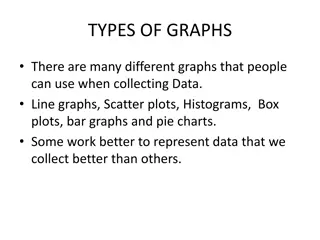Graphs and Testing Slides Adapted for Learning
This presentation covers various aspects of graphs and testing in Java programming. It explores concepts such as internal vs. external testing, representation invariants, and practical applications in real-world code. The slides include visual explanations of graph structures, paths, nodes, edges, and more. Additionally, there is a section dedicated to Java asserts and how they differ from exceptions in ensuring code correctness and robustness.
Download Presentation

Please find below an Image/Link to download the presentation.
The content on the website is provided AS IS for your information and personal use only. It may not be sold, licensed, or shared on other websites without obtaining consent from the author.If you encounter any issues during the download, it is possible that the publisher has removed the file from their server.
You are allowed to download the files provided on this website for personal or commercial use, subject to the condition that they are used lawfully. All files are the property of their respective owners.
The content on the website is provided AS IS for your information and personal use only. It may not be sold, licensed, or shared on other websites without obtaining consent from the author.
E N D
Presentation Transcript
Section 4: Graphs and Testing Slides adapted from Alex Mariakakis, with material from Krysta Yousoufian, Mike Ernst, and Kellen Donohue
Agenda Graphs Java assertions Internal vs. external testing Representation invariants in real code
Graphs B A C D E
Graphs B A Nodes C D E
Graphs B A Edges C D E
Graphs B A Children of A C D E
Graphs B A Parents of D C D E
Graphs B A Path from A to C C D E
Graphs B A Shortest path from A to C? C D E
Graphs B A Shortest path from A to B? C D E
Practical Graphs Petr Simecek s FB Mining
Practical (?) Graphs Chris Webb s Eurovision Voting
Java Asserts Demo!
Enabling Java Asserts Right click the .java file you are running Go to Run As Run Configurations Click on the Arguments tab Enter "-ea" under VM arguments
Assertions vs. Exceptions public class LitterBox { ArrayList<Kitten> kittens; public class LitterBox { ArrayList<Kitten> kittens; public Kitten getKitten(int n) { try { return kittens(n); } catch(Exception e) { } } } public Kitten getKitten(int n) { assert(n >= 0); return kittens(n); } } Assertions should check for things that should never happen Exceptions should check for things that might happen Exceptions address the robustness of your code, while assertions address its correctness
Java Asserts assert(someValue); where someValue is a non-obvious boolean someValue should always be true unless something is broken Asserts do not run unless specifically enabled Our autograder will enable them, so remember to enable asserts!
Internal vs. External Testing Internal: JUnit How you decide to abstract the object Checked with implementation tests If it s something you re testing about your implementation that might not be true for everyone s, it s internal. External: test script How the client uses the object Checked with specification tests If it s something that should be true for anybody s implementation from the same spec, it s external.
A JUnit Test Class A method with @Test is flagged as a JUnit test All @Test methods run when JUnit runs import org.junit.*; import static org.junit.Assert.*; public class TestSuite { ... @Test public void TestName1() { ... } }
JUnit Value Checking assertEquals, assertNull, assertNotSame, etc These are not the same as Java assert Verify that a value matches expectations: assertEquals(42, meaningOfLife()); assertTrue(list.isEmpty()); If the value isn t what it should be, the test fails Test immediately terminates Other tests in the test class are still run as normal Results show details of failed tests
JUnit Value Checking Assertion assertTrue(test) assertFalse(test) assertEquals(expected, actual) assertSame(expected, actual) assertNotSame(expected, actual) assertNull(value) assertNotNull(value) Case for failure the boolean test is false the boolean test is true the values are not equal the values are not the same (by ==) the values are the same (by ==) the given value is not null the given value is null And others: http://www.junit.org/apidocs/org/junit/Assert.html Each method can also be passed a string to display if it fails: assertEquals("message", expected, actual)
Checking for Exceptions Verify that a method throws an exception when it should Test passes if specified exception is thrown, fails otherwise Only time it s OK to write a test without a form of asserts @Test(expected=IndexOutOfBoundsException.class) public void testGetEmptyList() { List<String> list = new ArrayList<String>(); list.get(0); }
Setup and Teardown Methods to run before/after each test case method is called: public void name() { ... } @After public void name() { ... } @Before Methods to run once before/after the entire test class runs: @BeforeClass public static void name() { ... } @AfterClass public static void name() { ... }
Setup and Teardown public class Example { List empty; @Before public void initialize() { empty = new ArrayList(); } @Test public void size() { ... } @Test public void remove() { ... } }
Dont Repeat Yourself Can declare fields for frequently-used values or constants private static final String DEFAULT_NAME = MickeyMouse ; private static final User DEFAULT_USER = new User( lazowska , Ed , Lazowska ); Can write helper methods, etc. private void eq(RatNum ratNum, String rep) { assertEquals(rep, ratNum.toString()); } private BinaryTree getTree(int[] items) { // construct BinaryTree and add each element in items }
#1: Be descriptive When a test fails, JUnit tells you: Name of test method Message passed into failed assertion Expected and actual values of failed assertion The more descriptive this information is, the easier it is to diagnose failures Level of goodness Example Good testAddDaysWithinMonth() Not so good testAddDays1(), testAddDays2() Bad test1(), test2() Overkill TestAddDaysOneDayAndThenFiveDaysStartingOn JanuaryTwentySeventhAndMakeSureItRollsBack ToJanuaryAfterRollingToFebruary()
#1: Be descriptive Take advantage of message, expected, and actual values No need to repeat expected/actual values or info in test name Use the right assert for the occasion: assertEquals(expected, actual) instead of assertTrue(expected.equals(actual))
Lets put it all together! public class DateTest { ... // Test addDays when it causes a rollover between months @Test public void testAddDaysWrapToNextMonth() { Date actual = new Date(2050, 2, 15); actual.addDays(14); Date expected = new Date(2050, 3, 1); assertEquals("date after +14 days", expected, actual); }
Lets put it all together! public class DateTest { ... Tells JUnit that this method is a test to run // Test addDays when it causes a rollover between months @Test public void testAddDaysWrapToNextMonth() { Date actual = new Date(2050, 2, 15); actual.addDays(14); Date expected = new Date(2050, 3, 1); assertEquals("date after +14 days", expected, actual); }
Lets put it all together! public class DateTest { ... Descriptive method name // Test addDays when it causes a rollover between months @Test public void testAddDaysWrapToNextMonth() { Date actual = new Date(2050, 2, 15); actual.addDays(14); Date expected = new Date(2050, 3, 1); assertEquals("date after +14 days", expected, actual); }
Lets put it all together! public class DateTest { ... Use assertion to check expected results // Test addDays when it causes a rollover between months @Test public void testAddDaysWrapToNextMonth() { Date actual = new Date(2050, 2, 15); actual.addDays(14); Date expected = new Date(2050, 3, 1); assertEquals("date after +14 days", expected, actual); }
Lets put it all together! public class DateTest { ... Message gives details about the test in case of failure // Test addDays when it causes a rollover between months @Test public void testAddDaysWrapToNextMonth() { Date actual = new Date(2050, 2, 15); actual.addDays(14); Date expected = new Date(2050, 3, 1); assertEquals("date after +14 days", expected, actual); }
#2: Keep tests small Ideally, test one thing at a time Thing usually means one method under one input condition Not always possible but if you test x() using y(), try to test y() in isolation in another test Low-granularity tests help you isolate bugs Tell you exactly what failed and what didn t Only a few (likely one) assert statements per test Test halts after first failed assertion Don t know whether later assertions would have failed
#3: Be thorough Consider each equivalence class Items in a collection: none, one, many Consider common input categories Math.abs(): negative, zero, positive values Consider boundary cases Inputs on the boundary between equivalence classes Person.isMinor(): age < 18, age == 18, age > 18 Consider edge cases -1, 0, 1, empty list, arr.length, arr.length-1 Consider error cases Empty list, null object
Other Guidelines Test all methods Constructors are exception to the rule Keep tests simple Minimize if/else, loops, switch, etc. Don t want to debug your tests! Tests should always have at least one assert Unlesstesting that an exception is thrown Testing that an exception is not thrown is unnecessary assertTrue(true)doesn t count! Tests should be isolated Not dependent on side effects of other tests Should be able to run in any order
JUnit Summary Tests need failure atomicity so we know exactly what failed Each test should have a descriptive name Assert methods should have clear messages to know what failed Write many small tests, not one big test Test for expected errors / exceptions Choose a descriptive assert method, not always assertTrue Choose representative test cases from equivalent input classes Avoid complex logic in test methods if possible Use helpers, @Before to reduce redundancy between tests
External Testing This is for your client (us!) HW5 and on, class specifications are no longer provided; everyone s might be different So how do we test your code?
Test Script Language Text file with one command listed per line First word is always the command name Remaining words are arguments Commands will be translated to some method(s) in your code
Test Script Language # Create a graph CreateGraph graph1 # Add a pair of nodes AddNode graph1 n1 AddNode graph1 n2 n1 n2 # Add an edge AddEdge graph1 n1 n2 e1 # Print the nodes in the graph and the outgoing edges from n1 ListNodes graph1 ListChildren graph1 n1
Test Script Language CreateGraph A AddNode A n1 AddNode A n2 n1 n2 CreateGraph B ListNodes B AddNode A n3 AddEdge A n3 n1 e31 AddNode B n1 AddNode B n2 AddEdge B n2 n1 e21 AddEdge A n1 n3 e13 AddEdge A n1 n2 e12 n3 n1 n2 ListNodes A ListChildren A n1 ListChildren B n2
CheckRep: Linked List public void insert(element e) { checkRep(); // Do things! } checkRep();
CheckRep private void checkRep() { // Checks invariants: ordered linked list quick! check list not null depends check list elements are in ascending order quick! check list first.prev is null ... }
CheckRep private void checkRep() { // Checks invariants: ordered linked list check list not null if(Thisprogram.DEBUG) check list elements order check list first.prev is null ... }
CheckRep When should DEBUG = true? While debugging When should DEBUG = false? When submitting code Or, whenever speed is important Performance tests (not for 331!) HW6 grading timeouts While coding, sometimes(you don t want to wait thirty minutes to test every time you change code)























